Eye tracking gaze.
Optiwise receives funding from the Horizon Europe research programme under grant agreement No. 101056769.

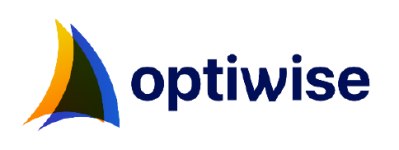
Create a MARIN account to stay updated

Report
June 2025, no. 144
www.linkedin.com/company/optiwise-eu

www.marin.nl/jips/optiwise

More info
Simulation displaying pupil size, indicating decreases in cognitive demand over time.
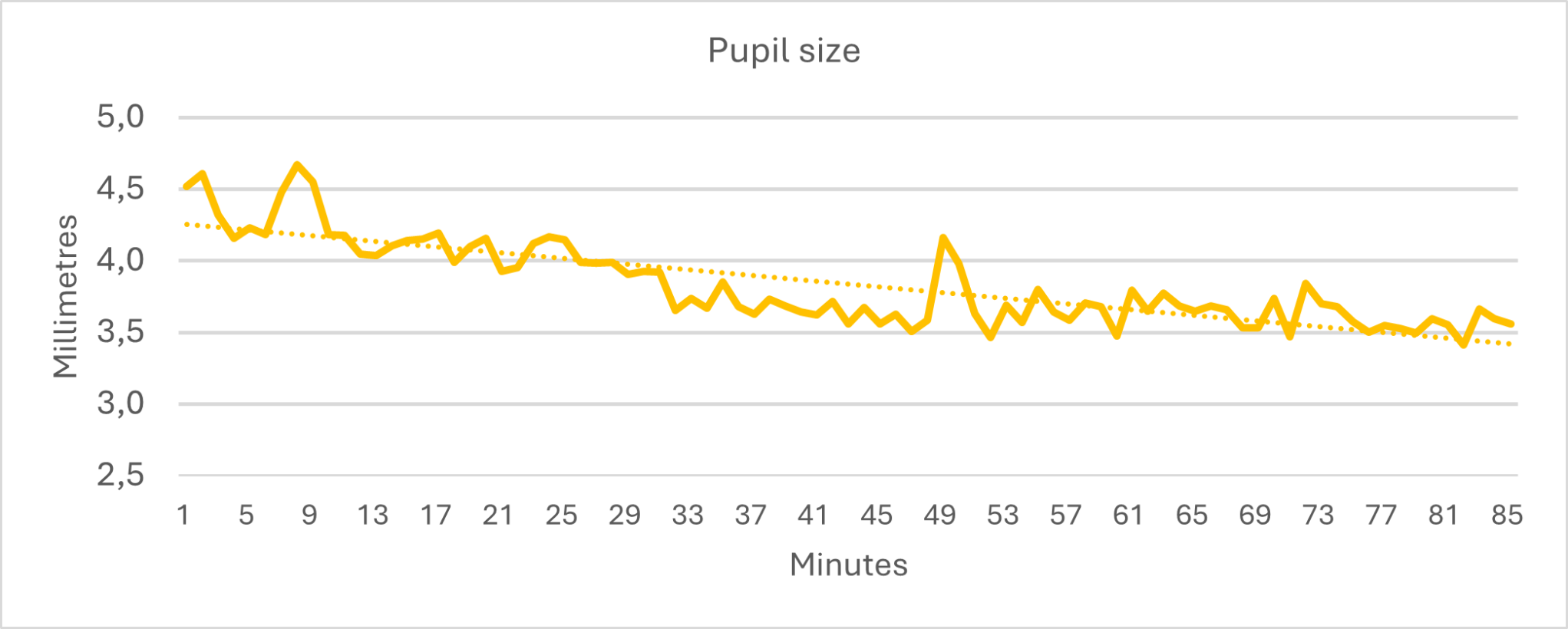
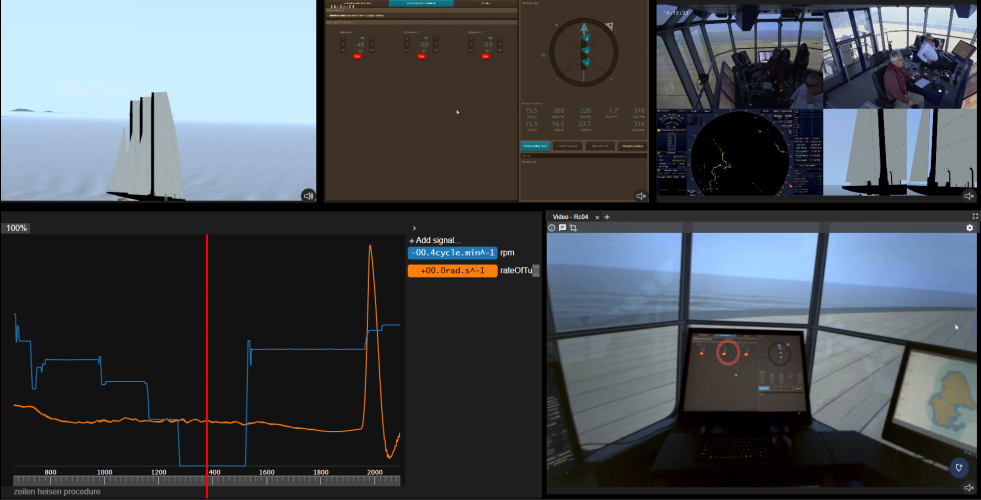
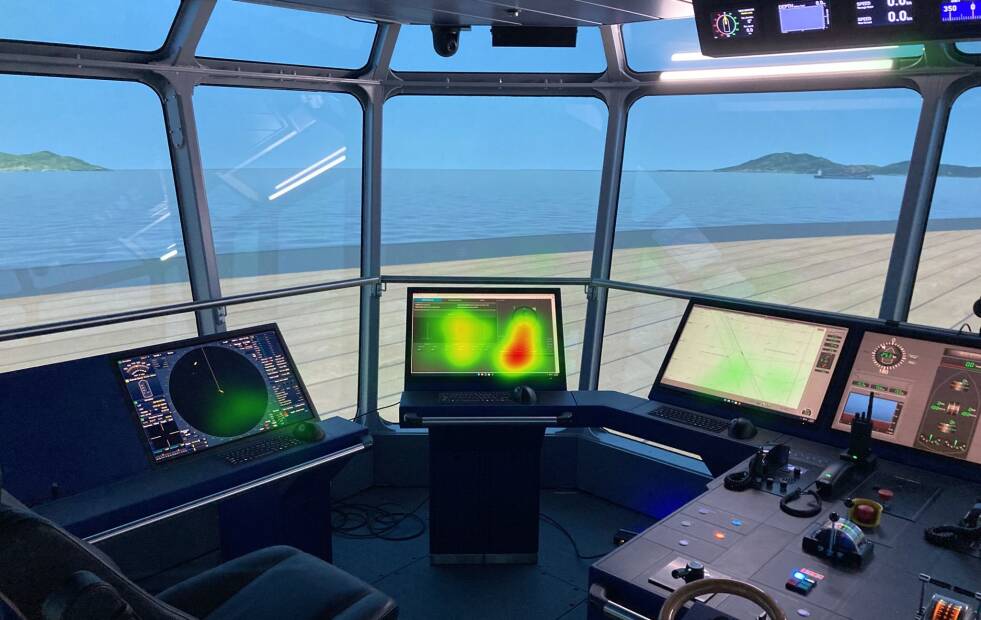
Synchronised data recording with video footage, simulator and eye-tracking data.
Interested? Contact us to discuss your options
Designing from the operator’s perspective
A key part of the study was designing and testing the Human-Machine Interface (HMI) for wind-assisted propulsion systems. MARIN applied a Human-Centred Design (HCD) approach, prioritising end-user involvement. HCD enables developers to design from the operator's perspective, incorporating continuous feedback loops during the design to achieve first-time-right development.
The process involves understanding the operational environment, defining user needs, creating and refining designs through iterative testing, and testing in real-world scenarios to gather feedback and make adjustments. This ensures the system evolves effectively to meet user needs.
Getting the full benefit of wind propulsion requires that the crew is fully supported with well-designed systems to perform their tasks. After all, if the crew is unable to operate the system effectively, the overall ship performance will be far from optimal.
This work is part of Optiwise, a three-year Horizon Europe project focused on developing holistic design and control strategies for wind-assisted vessels. As part of the project, bridge simulations were used to explore how wind propulsion affects onboard operations.
As the maritime sector pushes toward greener solutions, wind-assisted propulsion has emerged as a promising way to cut emissions and boost fuel efficiency.
Enhancing wind propulsion performance through human-centred design and bridge simulations
Developing Human-Machine Interfaces by employing Human-Centred Design principles through an iterative process. Showing different design cycles.
Human-Centred Design approach consists of four steps for optimal end-user involvement in the development of new concepts.
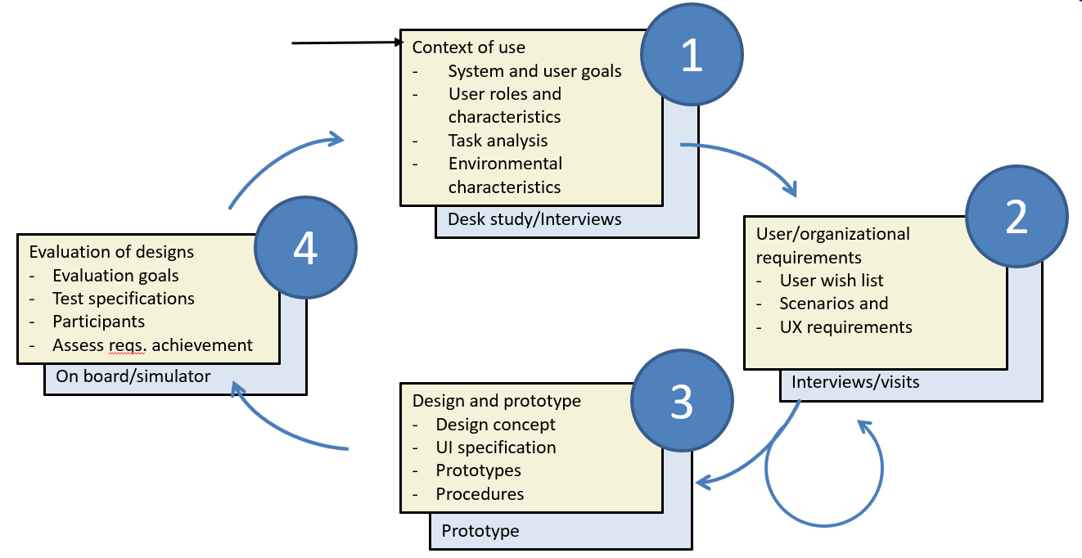
“This work is part of Optiwise, a three-year Horizon Europe project focused on developing holistic design and control strategies for wind-assisted vessels.”

Supporting the crew with a well-designed HMI
Adopting industry-standard user interface guidelines for wind propulsion can enhance the optimal and consistent use of these systems. As this study proved, a well-designed HMI supports the crew to effectively perform their tasks.
Furthermore, integrating wind propulsion systems with other onboard systems is vital for ensuring correct usage and immediate feedback, allowing operators to access and utilise information at the right moment. Involving end-users in the design of new concepts or decision support tools is essential for effective operations and achieving first-time-right development.
Gaze patterns
To assess situational awareness and interaction with the HMI, eye-tracking technology was used to monitor gaze patterns in real time. This provided valuable insights into how and when operators accessed critical information. Heatmaps generated during the post-analysis revealed where the operator was looking, in turn giving insight into system usage and interaction levels, supporting deeper evaluation through interviews and discussions.
Eye-tracking & analysing pupil size
In addition to collecting information about interactions with onboard systems, we also analysed pupil size. Research indicates that pupil size increases when situations become more cognitively challenging. By analysing this data, we can determine if a scenario is perceived as cognitively demanding, providing valuable insights into whether operators experienced any difficulties during the simulations. Throughout the simulations, we observed that their pupil size decreased in all but one scenario, indicating a reduction in cognitive demand. This trend suggests that scenarios begin with a degree of uncertainty, requiring operators to first acclimatise to the scenario and onboard systems.
Integrating wind propulsion into a vessel fundamentally alters onboard operations. Operators must reassess situations, taking into account factors such as ETA, wind conditions, and optimal routing - an approach that differs significantly from current practices. These operational changes necessitate the development of cleverly designed, task-supporting HMI, new procedures and the identification of training needs and requirements to ensure operators are well prepared.
Assessing new HMI by using the Large Motion Simulator
The fourth step of the HCD process entails evaluation of the design. To evaluate the new HMI and the impact on the operators on board, bridge simulations were performed using MARIN’s Large Motion Simulator (LMS). Four scenarios - excluding familiarisation - placed operators in varied conditions, allowing researchers to observe responses and operational behaviour.
During these simulations, we collected data from multiple sources, including observations, interviews, and discussions, to understand the operators' experiences and identify key aspects. We also used questionnaires to evaluate their performance, attitudes, and training needs. Each simulation was recorded, capturing video footage of the bridge and the HMI, along with synchronised simulator data. This comprehensive recording allowed us to pinpoint and reflect on significant moments after the simulations.
Using the HCD approach, an operational task-oriented control system for wind-assisted propulsion was developed and evaluated through advanced bridge simulations. The process started with the first step - ‘context of use’. Task analysis and user sessions were performed to capture the bridge operators' needs. These insights led to user requirements (step 2) and shaped early design sketches (step 3), which evolved into a refined interface through iterative design and continuous feedback loops with end-users.





Optiwise receives funding from the Horizon Europe research programme under grant agreement No. 101056769.

Supporting the crew with a well-designed HMI
Adopting industry-standard user interface guidelines for wind propulsion can enhance the optimal and consistent use of these systems. As this study proved, a well-designed HMI supports the crew to effectively perform their tasks.
Furthermore, integrating wind propulsion systems with other onboard systems is vital for ensuring correct usage and immediate feedback, allowing operators to access and utilise information at the right moment. Involving end-users in the design of new concepts or decision support tools is essential for effective operations and achieving first-time-right development.
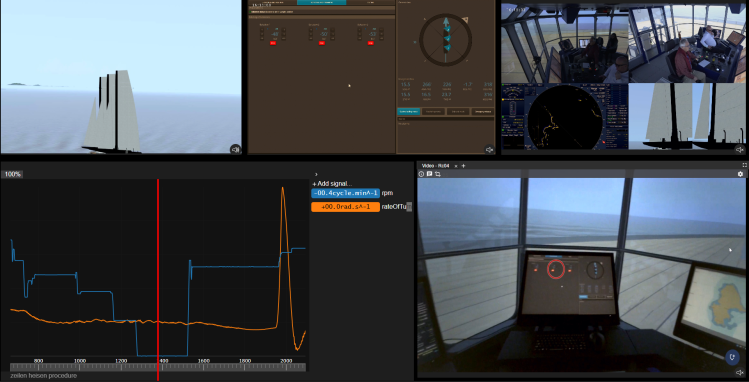
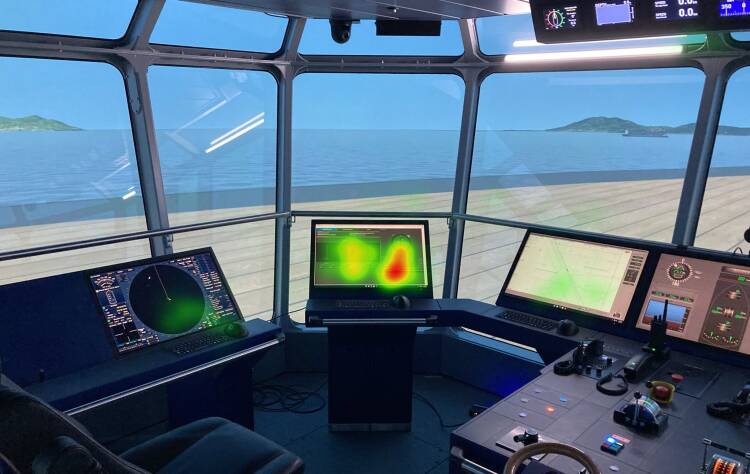
Synchronised data recording with video footage, simulator and eye-tracking data.
Developing Human-Machine Interfaces by employing Human-Centred Design principles through an iterative process. Showing different design cycles.
Designing from the operator’s perspective
A key part of the study was designing and testing the Human-Machine Interface (HMI) for wind-assisted propulsion systems. MARIN applied a Human-Centred Design (HCD) approach, prioritising end-user involvement. HCD enables developers to design from the operator's perspective, incorporating continuous feedback loops during the design to achieve first-time-right development.
The process involves understanding the operational environment, defining user needs, creating and refining designs through iterative testing, and testing in real-world scenarios to gather feedback and make adjustments. This ensures the system evolves effectively to meet user needs.
www.linkedin.com/company/optiwise-eu

June 2025, no. 144
www.marin.nl/jips/optiwise

More info
Simulation displaying pupil size, indicating decreases in cognitive demand over time.
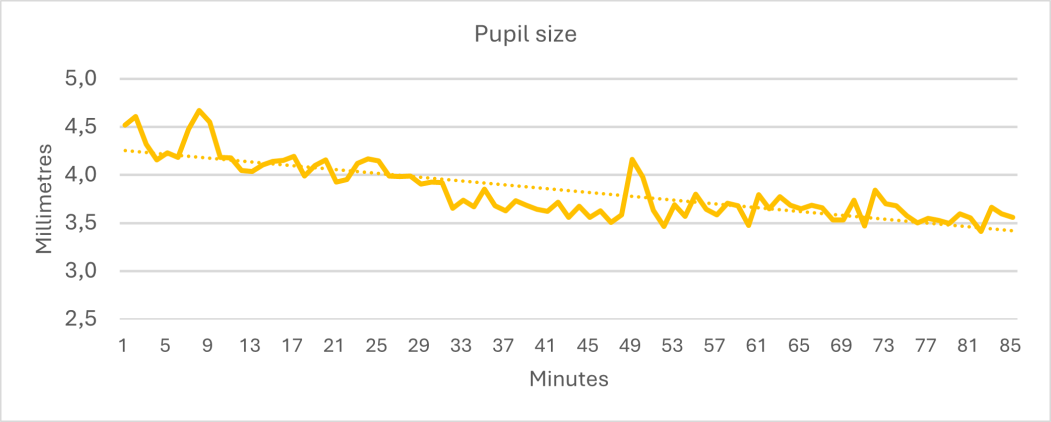
Gaze patterns
To assess situational awareness and interaction with the HMI, eye-tracking technology was used to monitor gaze patterns in real time. This provided valuable insights into how and when operators accessed critical information. Heatmaps generated during the post-analysis revealed where the operator was looking, in turn giving insight into system usage and interaction levels, supporting deeper evaluation through interviews and discussions.
Eye-tracking & analysing pupil size
In addition to collecting information about interactions with onboard systems, we also analysed pupil size. Research indicates that pupil size increases when situations become more cognitively challenging. By analysing this data, we can determine if a scenario is perceived as cognitively demanding, providing valuable insights into whether operators experienced any difficulties during the simulations. Throughout the simulations, we observed that their pupil size decreased in all but one scenario, indicating a reduction in cognitive demand. This trend suggests that scenarios begin with a degree of uncertainty, requiring operators to first acclimatise to the scenario and onboard systems.
Integrating wind propulsion into a vessel fundamentally alters onboard operations. Operators must reassess situations, taking into account factors such as ETA, wind conditions, and optimal routing - an approach that differs significantly from current practices. These operational changes necessitate the development of cleverly designed, task-supporting HMI, new procedures and the identification of training needs and requirements to ensure operators are well prepared.
As the maritime sector pushes toward greener solutions, wind-assisted propulsion has emerged as a promising way to cut emissions and boost fuel efficiency.
Getting the full benefit of wind propulsion requires that the crew is fully supported with well-designed systems to perform their tasks. After all, if the crew is unable to operate the system effectively, the overall ship performance will be far from optimal.
This work is part of Optiwise, a three-year Horizon Europe project focused on developing holistic design and control strategies for wind-assisted vessels. As part of the project, bridge simulations were used to explore how wind propulsion affects onboard operations.
Enhancing wind propulsion performance through human-centred design and bridge simulations
Assessing new HMI by using the Large Motion Simulator
The fourth step of the HCD process entails evaluation of the design. To evaluate the new HMI and the impact on the operators on board, bridge simulations were performed using MARIN’s Large Motion Simulator (LMS). Four scenarios - excluding familiarisation - placed operators in varied conditions, allowing researchers to observe responses and operational behaviour.
During these simulations, we collected data from multiple sources, including observations, interviews, and discussions, to understand the operators' experiences and identify key aspects. We also used questionnaires to evaluate their performance, attitudes, and training needs. Each simulation was recorded, capturing video footage of the bridge and the HMI, along with synchronised simulator data. This comprehensive recording allowed us to pinpoint and reflect on significant moments after the simulations.
Using the HCD approach, an operational task-oriented control system for wind-assisted propulsion was developed and evaluated through advanced bridge simulations. The process started with the first step - ‘context of use’. Task analysis and user sessions were performed to capture the bridge operators' needs. These insights led to user requirements (step 2) and shaped early design sketches (step 3), which evolved into a refined interface through iterative design and continuous feedback loops with end-users.
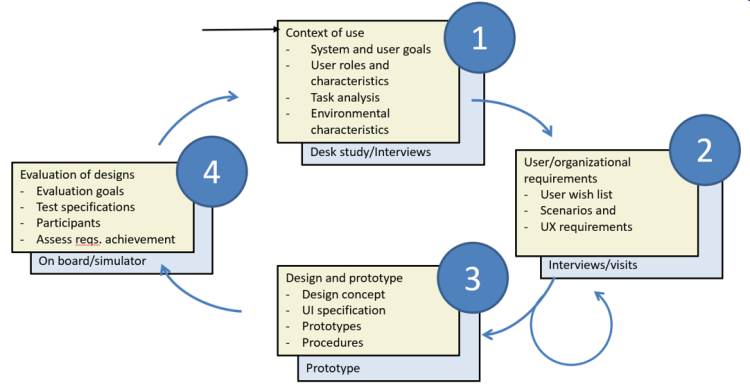
Human-Centred Design approach consists of four steps for optimal end-user involvement in the development of new concepts.
“This work is part of Optiwise, a three-year Horizon Europe project focused on developing holistic design and control strategies for wind-assisted vessels.”

Interested? Contact us to discuss your options
Create a MARIN account to stay updated





Report





